Triumph Motorcycles is one of the biggest motorcycle companies in the world. Prior to the growth of the Japanese motorcycle brands, British motorcycle brands used to dominate the motorcycle landscape around the world, and Triumph was one of these companies. By the late 1960s, Triumph exported about 60% of its production motorcycles holding a large market share worldwide. The bikes enjoyed the most-coveted public image, thanks to their aesthetically appealing, fast, and agile roadsters. However, Triumph’s journey to success and recognition was not a smooth one. From rise to demise and revival, the company has seen and overcome many challenges. Today, Triumph has become the fastest-growing motorcycle company in the world, especially in the United States. In this article, we will take a look at Triumph’s iconic motorcycles that contributed to the brand’s rise and revival.
Table of Content
1. The Story of Triumph Motorcycles
The Triumph Motorcycle company began in 1885 after Seigfried Bettman migrated from Germany to England. Siegfried Bettmen began selling bicycles in Coventry under the name Triumph Cycle Company. After three years, the company manufactured the first Triumph original bicycle. In 1902, the brand introduced its first motorcycle, which was essentially a bicycle with a Belgian Minerva engine. By 1903, the company had sold 500 motorcycles and moved its production camp to the Nuremberg factory.
1.1 Creating Original Triumph Engine & Triumph A Model
In 1905, Triumph launched an in-house model, After this milestone achievement, the company developed into a fully-operational motorcycle company. In 1905, Triumph began building its own engines only three years after entering the motorcycle business. Creating an original Triumph engine was a milestone achievement for the brand. At that time, other motorcycle companies used the John Alfred Prestwich (JAP) engines in their bikes. Triumph fitted this engine in an in-house model, the Triumph A model. This motorcycle was also called Triumph 31/2 HP and was powered by the new 499 cc single-cylinder four-stroke original Triumph engine that could generate 3.5 hp of horsepower.
1.2 Role of Triumph Motorcycles in World War I
The motorcycle company continued to thrive during World War I, when most British motorcycle companies ceased operations. The Model H Roadster was produced in 1915 and served as a reliable tool for communication, supply transportation, and reconnaissance. The Model H Roadster was powered by a 550 cc four-stroke side valve single-cylinder engine. The low-maintenance belt drive was another special feature of the bike, making it suitable for military use. The bike remained in production long after World War I ceased and was discontinued in the 1930s.
1.3 Role of Triumph Motorcycles in World War II
During the Second World War, the city of Coventry was completely destroyed in the Coventry Blitz, In 1942, Triumph began production at the new manufacturing plant at Meriden.
1.4 The Rise & Decline
In the post-World War II era, Triumph became the world’s largest motorcycle manufacturer, and the 60s was the peak decade of production and sales. By 1969, Triumph held 50% of the American market share in the above 500cc motorcycle category. However, the 1970s marked the demise of the company. During this decade, Triumph motorcycles demonstrated quality issues, oil leaks, electrical malfunction, and carburetor issues. In the late 1970s, the company began facing financial issues and underwent ownership changes due to which motorcycle production reduced significantly. The Japanese motorcycles raised the bar higher with their technologically advanced yet cheaper motorcycles. When compared to the Honda’s CB750 the Triumph motorcycles looked even more outdated and overpriced.
1.5 The Revival of Triumph Motorcycles
If it were any other company, it would have become defunct. But Triumph motorcycles bounced back in 1983 when John Bloor bought the brand name and manufacturing rights. Under John Bloor, the company was renamed Triumph Motorcycle Limited. Bloor focused on rebuilding the brand before launching a new product. Bloor managed to conserve the company’s historical significance while simultaneously equipping the bike to meet the demands of the modern world.
2. 10 Best Triumph Motorcycles of All Time
Triumph has been producing motorcycles for over twelve decades, and it seems that it has created an iconic bike in each decade except for the 1970s. Since some motorcycles became more popular than others, this list includes all the legendary Triumph motorcycles that revolutionized motorcycling.
2.1 The Triumph Model R Ricardo
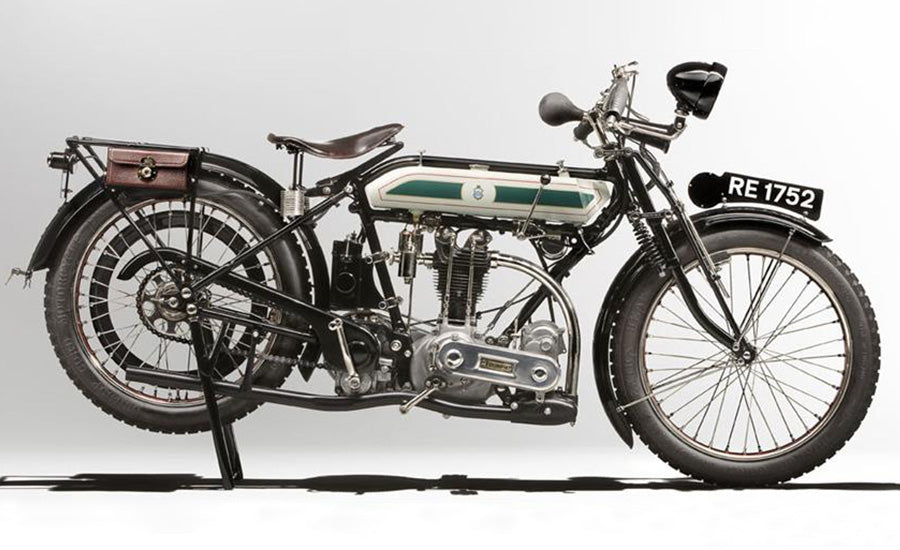
The Model R Ricardo was introduced by Triumph in 1921, and the bike was discontinued seven years later in 1928. This motorcycle was equipped with the revolutionary four-valve head four stroke single cylinder engine, designed by Sir Harry Ricardo. Model R Ricardo had a top speed of 70 mph and 20 hp of horsepower that helped it break three speed records. In addition, the Model R Fast Roadster won a gold medal in the 1923 International Six-Day Trial. Before this achievement, three Ricardo models failed to perform in the 1921 Isle of Man TT as only one motorcycle completed the race. In the 1922 Single TT, Triumph entered the Model R Fast Roadster model. Ricardo’s assistant and engine designer Frank Halford rode the Model R and secured 13th position in the race. Frank Halford then tuned this model and installed a bronze alloy cylinder head in it. The modified bike recorded a lap of 68 mph at the Brooklands racing track. Then it recorded 76.74 mph, which broke the Brooklands hour record. Next, the bike recorded the top speed of 87.8 mph, known as the flying mile. The top speed was improved not only because of engine tuning. Harry Ricardo’s racing fuel augmented the bike’s top speed; these fuels got banned eventually.
Today Model R Ricardo is a coveted vintage motorcycle and is considered valuable with a high price tag.
2.2 The Triumph Speed Twin
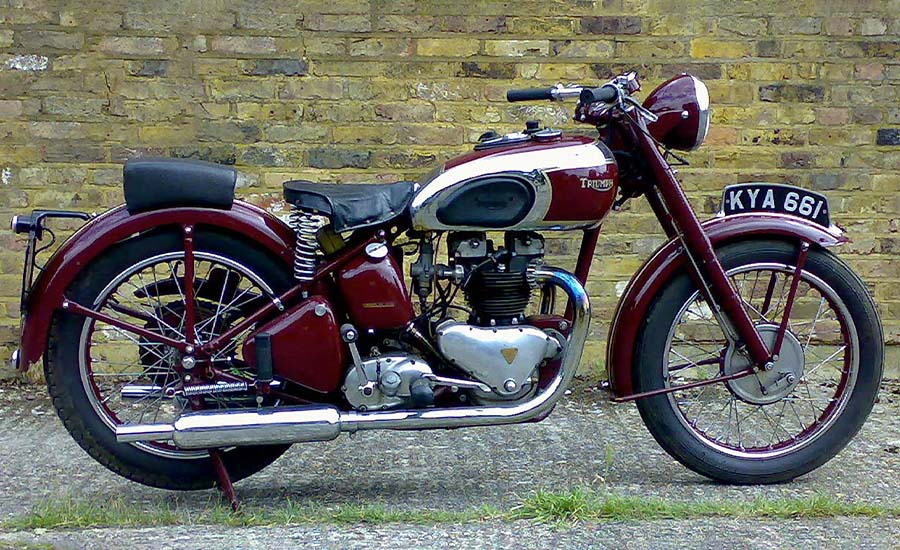
Designed by Edward Turner, the Triumph Speed Twin was the first revolutionary model of the pre-World War II era. Introduced in 1937, the Triumph Speed Twin was the first bike that popularized the concept of a versatile motorcycle capable of performing equally well on urban streets, race tracks, and highways.
Being one of the lightest, fastest, and most powerful motorcycles of its time, the Triumph Speed Twin soon became a success in the international markets, especially in the United States. This achievement compelled Triumph to focus on producing bigger motorcycles for international markets. However, the production and sales of the Speed Twin were interrupted because of World War II, when the company adapted the motorcycle to support the armed forces. These military models of Speed Twin came with special features and served as a communication tool.
After World War II, Triumph used the existing Speed Twin platform to innovate new bikes, such as the Thunderbird 650 and the Tiger 100, with better capacities and improved features.
The role of Triumph Speed Twin in World War II made it one of the most popular motorcycles of its time. The bike was powered by a 500 cc parallel twin engine with overhead valves. This new engine design offered better engine outputs, a high rate of acceleration, and a smooth power delivery. The Triumph Speed Twin defined the brand’s legacy and became the basis of many future motorcycles.
2.3 The Triumph 3TW 350

The Triumph 3TW 350 was launched in the 1940s and was part of the post-WWII lineup. The TW350 was based on the 350cc Tiger 85, a bike discontinued in 1939. However, the bike was used to create the 3TW 350 in response to the Ministry of Supply’s requirements. The alloy frame and engine allowed the motorcycle to meet the weight standards of the ministry that the motorcycle should weigh less than 250 lbs. Since aluminum alloy was expensive and in short supply, the company created a cast iron engine that was within the weight requirements of the ministry. The Triumph 3TW was a bit too powerful for the ministry, so the engineers tuned down the engine outputs
The 3TW gained popularity for its dual-purpose riding. Since the motorcycle could handle various terrains it was used for tasks other than recreational riding and transportation, including agricultural work, message delivery, utility tasks, and industrial use. The motorcycle was powered by a 350cc overhead valve engine and featured a four-speed transmission that offered adequate power and control for off-road and on-road riding. Unfortunately, only a few T3W motorcycles were supplied as the Triumph’s Priory Street Works got destroyed during the Coventry Blitz. All the machines and tools required to produce the T3W were completely destroyed.
2.4 The Triumph Tiger Cub

The Triumph Tiger Cub was introduced in the Earl Court Show in 1953. This 200 cc motorcycle was based on the 150cc Triumph T15 Terrier, designed by Edward Turner, and manufactured at the Meriden Factory. The motorcycle gave tough competition to other motorcycles in the same category. The first Tiger Cub motorcycle featured the same front suspension and plunger rear-suspension frame as the T15 Terrier. In 1957, the suspension system was improved and a modern rear-swing arm with dual-suspension unit was installed. The ignition points of the bike were repositioned. In 1963 Triumph models, the ignition points were positioned on the end of the camshaft and could be accessed through the cover present below the base of the cylinder. In 1961 when the driving license law in Great Britain restricted learners to practice riding on motorcycles under 250cc, the Triumph Tiger Cub became the vehicle of choice for many riders who wanted to learn how to ride a motorcycle. Arguably, the Triumph Tiger Cub was a good-looking motorcycle and offered reliability on race tracks, paved roads, and off-road trails. Many riders call it the best-looking Triumph of the 1950s. However, this iconic motorcycle also had undesirable features. In 1968, Triumph discontinued the production of the Tiger Cub.
2.5 The Triumph TR6 Trophy
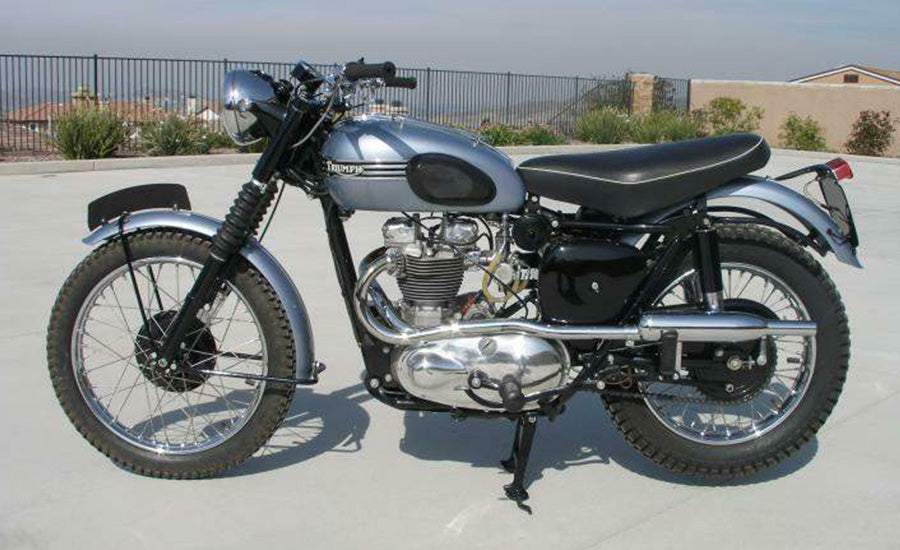
The Triumph TR6 Trophy was introduced in 1956 and had a 17-year long production run. Triumph discontinued its production in 1973 and replaced it with the Triumph Tiger TR7V, a motorcycle featuring 750 cc engine and a five-speed transmission system. Throughout its production run, the TR6 Trophy was a successful motorcycle, and had a huge fanbase in the United States. In fact the TR6 Trophy was designed specifically to meet the demand for high-performance motorcycles from the American market. These motorcycles were also frequently used for desert racing in California.
Other than the production model, Triumph also introduced a race model, called the Desert Sled, which won various competitions in the 1950s and 1960s. The bike gained even more popularity when Steve McQueens used it in the 1964 International Six Day Trials. Even though McQueens didn’t win this multi-day event, his participation is enough to popularize the motorcycle and off-road riding.
The 1956 TR6 Trophy model was named the TR6 Trophy-bird (after the Thunderbird) and featured the same T110 engine. The engineers tweaked the engine by adding alloy cylinder heads, Delta, on this model. The two-into-one exhaust system, seven-inch front brake, and smooth power delivery made TR6 Trophy an ideal dual-purpose motorcycle. In 1957 models, the front brake setup was improved and the Lucas Red Label Competition Magneto ignition system was added as a standard feature. In 1959, a scrambler and roadster variant of the TR6 Trophy were introduced. In 1961, the bike’s name was changed from TR6 Trophy-bird to TR6 Trophy. The performance and reliability of the TR6 Trophy motorcycles was further cemented when the British police department started using them. The model for UK police forces had a special code, TR6P. After UK police, the US police department also utilized TR6 Trophy bikes (coded TR6SS) for its duties.
2.6 The Triumph Bonneville

The Triumph Bonneville is arguably the most well-known motorcycle in the history of British motorcycles. The Bonneville came with a new revolutionary engine and has a unique lineage that connects it to the original Triumph Speed Twin. The Triumph Bonneville succeeded the TR6 Trophy, which came from the Thunderbird 650. The Thunderbird 650 was essentially derived from the Tiger 500, a bike based on the Speed Twin. Bonneville is much faster and lighter than the 1937 Speed Twin, yet riders consider it to be an improved version of the Speed Twin because both bikes share the same platform.
The Triumph Bonneville was so popular that the company launched three different generations, each having a long production run.
The first generation was produced between 1959-1983, the second generation was produced between 1985-1988, while the third generation Bonnevilles was introduced in 2001 and is still continuing. In the Bonneville series, the following motorcycles were the best:
The 1959 Triumph Bonneville T120
The Bonneville T120 was the first Bonneville and Edward Turner’s last motorcycle design. The bike was based on the Triumph Tiger T110 and featured a four-stroke parallel twin engine with twin-carburetors. In addition, the motorcycle had a top speed of 115 mph without any modification. Later Bonneville T120 models a unique frame called the oil in frame.
The Bonneville T120 was designed at the request of an American motorcycle importer who needed a fast motorcycle that would appeal to the American motorcycle enthusiasts. The bike was named Bonneville after the Bonneville Salt Flats in Utah, where tried to break multiple speed records.
The 1965 Triumph Thruxton (T120R Bonneville)
Triumph T120R Bonneville or Thruxton was a limited edition production race bike introduced in 1965. The bike was named after the epic victory of Tony Godfrey and John Holder in the 1962 Thruxton 500. Both racers used the Bonneville T120 in the competition. The bike was modified with precision-machined crankcase and engine cylinder heads to increase the horsepower up to 53 bhp.
The 1966 Triumph T120TT Bonneville
The Triumph T120TT Bonneville or the TT Special was a competition variant of the T120C Bonneville. This export model was basically a T120C without a number plate and lighting. The exhaust of the TT Special was tuned for racing. The motorcycle gained immense popularity after Evel Knievel used it to perform his famous jump over the Caesar Palace fountain in Las Vegas.
The 2012 Triumph Bonneville T100
In 2012, Triumph launched a limited edition Bonneville T100 model also known as the Steve McQueen edition. The bike was produced to commemorate Steve McQueen’s famous motorcycle stunt in the 1962 movie “The Great Escape.” Though the bike used in the movie was a Triumph TR6, the Bonneville100 garnered a reputation for being an exact replica. This military bike was extremely successful and got sold out immediately. It commands a high sale price even today.
The 2019 Triumph Bonneville T120 Diamond
In 2019, Triumph introduced the Triumph Bonneville T120 Diamond edition. This limited edition motorcycle boasted high-tech features. The Diamond was launched on the 60th anniversary of the company and is considered the best Bonneville model of all time. The bike was powered by a 1200 cc engine. The chrome engine covers, two-tone silver/white paint, and special badging summed up the styling. Only 900 units were produced that got sold out immediately. The Diamond is one of the most coveted Bonneville in the second hand market.
2.7 The Triumph Trident

The Trident model was launched in 1969 and was the first official superbike produced by Triumph. The bike featured large side covers, vintage lighting, distinct shoebox fuel tank, chrome accents, and ray gun mufflers. By the time the Trident was introduced, Honda was working on the CB750. The Trident paled in comparison and its old-fashioned Bonneville-inspired parts failed to impress the motorcycle enthusiasts.
A new generation of the Triumph Trident was introduced as the 1991 model at the 1990 Cologne Motorcycle Show. The new Trident model was available in two variants: 750 cc and 900 cc. Triple-cylinder liquid-cooled double overhead camshaft engines powered these motorcycles. 2010 Motor Cycle News declared the Trident 900 motorcycle the best machine. With flexible handling, robust frame, and exceptional riding comfort, the 900 Trident outperformed all other roadsters of its time.
2.8 The Triumph Tiger 800
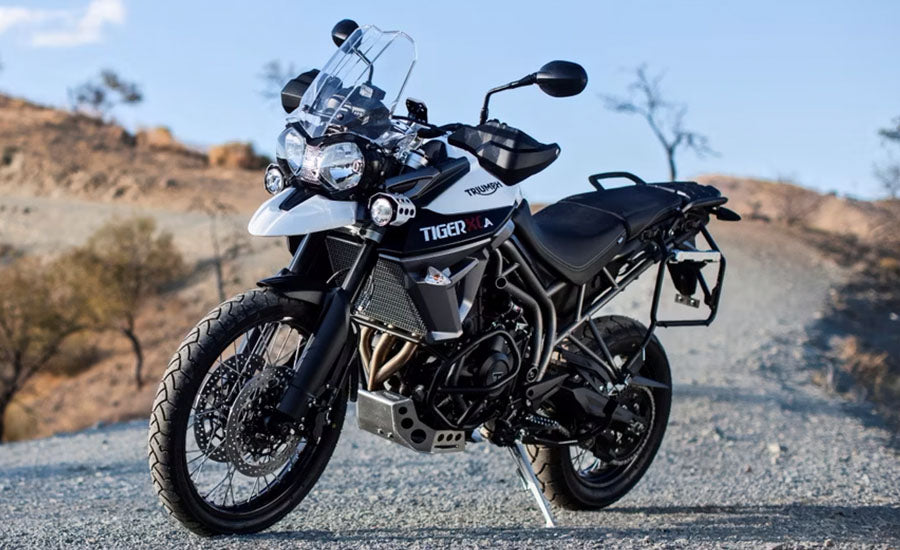
The Triumph Tiger 800 was launched in 2010 and quickly became the best-selling dual-sport bike. The model was available in two variants:
- The Triumph Tiger 800 XC for exceptional off-road performance.
- The Triumph Tiger 800 XR for better on-road performance.
After 2019, the company discontinued the production of the Tiger 800 only to replace the bike with an improved Tiger 900 model.
The first generation Triumph Tiger 800 was powered by a 799 cc inline three-cylinder engine based on the Triumph Daytona 675 model. The second-generation Triumph Tiger 800 motorcycles were equipped with a drive-by-wire throttle system that improved fuel efficiency up to 17%. Multiple riding modes, traction control, and adjustable front forks were also added.
The third generation Triumph Tiger 800 motorcycles were equipped with ABS, front and rear disc brakes, different riding modes, and digital instruments.
The Triumph Tiger 800 was a versatile high-performance dual-sport, great for riders looking to explore the adventure touring segment.
2.9 Triumph Rocket III
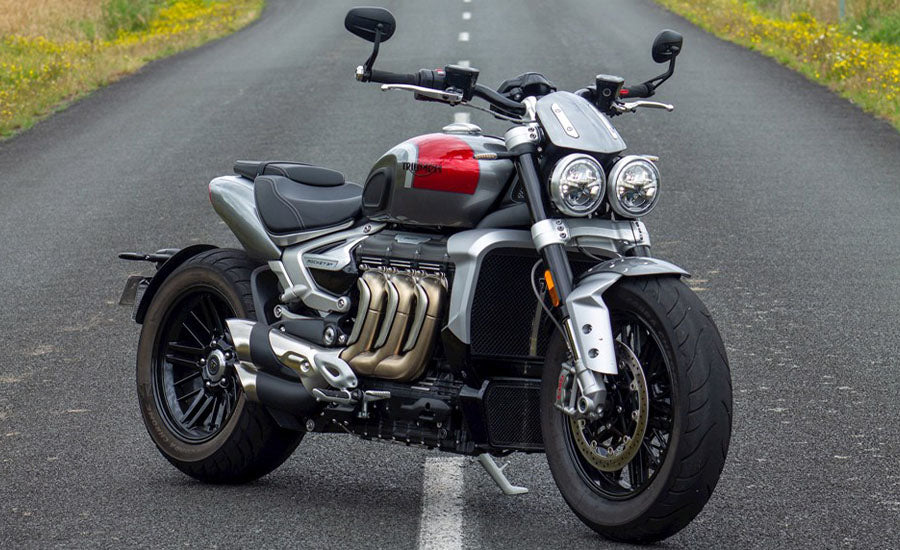
Designed for the American cruiser market, Triumph Rocket III was launched in 2004. The three-cylinder motor of this motorcycle displaced 2,294 cc, making the Triumph Rocket III famous for featuring the largest displacement-engine of any other production motorcycle. However, the Rocket III was unable to compete with the Harley Davidson even though the company had claimed it to be better than any Harley model at that time. As a result, it shifted its focus to attract riders who preferred muscle bikes and roadsters. Although the bike didn’t gain much success in the cruiser market, it still managed to carve out a niche for itself.
2.10 Triumph Speed Triple
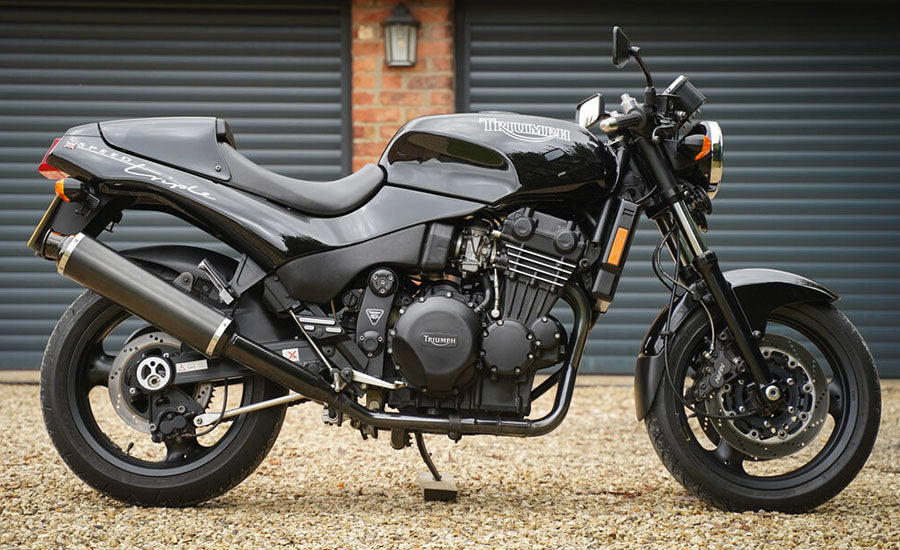
The Triumph Speed Triple was launched in 1994 and was the first streetfighter style motorcycle by the British brand. It was a unique race/sport bike devoid of plastic bodywork, a style popularized by racers who converted their high-speed motorcycles into street bikes by stripping off their fairings. The bike also took design inspiration from the 1937 Triumph Speed Twin. Many claim that the revolutionary Speed Triple saved the company from going defunct by popularizing the brand name along with the streetfighter genre.
3. Last Words
Triumph’s engineering genius allowed it to create competitive race bikes for the streets. These motorcycles were considered the fastest motorcycles on the road. Even after decades of production, the company is dedicated to designing fast, powerful, street-legal motorcycles for its fans. While many companies managed to provide fast high-performing motorcycles to the riders; however, they were unable to match the use of ease so unique to Triumph motorcycles. The Triumph parallel twin technology with its simple design not only made the bikes fun to ride, but ensured reliability, ease of maintenance, and comfort. Today, Triumph motorcycles are popular not just for their technological features and engineering but also for their historical significance.












Leave a comment
All comments are moderated before being published.
This site is protected by hCaptcha and the hCaptcha Privacy Policy and Terms of Service apply.